Residual Stress Reduction Technology in Heterogeneous Metal Additive Manufacturing
Abstract
1. Introduction
2. Materials and Methods
3. Results and Discussion
4. Conclusions
- The change in laser power during additive processing and the residual stress of the material exhibited no specific correlation. In the AM process, heating and cooling were repeated for a partial area; therefore, it is predicted that change in laser power did not significantly affect the change in temperature of the entire base material or the output.
- The reduction in residual stress is confirmed when applying the real-time heating technology in the sample-level experiment. In addition, the results of this study demonstrate that the maximum residual stress generation point can be changed by applying real-time heating technology.
- In the case of the hot mold work steel specimen manufactured under real-time heating conditions, as a result of observation with an optical microscope, the carbide layer and the general layer were not distinguished, and the particles were small and uniformly distributed. This is believed to be the result of the effect of reducing the temperature deviation during melting and cooling in the AM process.
- Moreover, reducing the residual stress was also confirmed on large-area curved specimens.
Author Contributions
Funding
Acknowledgments
Conflicts of Interest
References
- Milewski, J.O. Additive Manufacturing of Metals: From Fundamental Technology to Rocket Nozzles, Medical Implants, and Custom Jewelry; Springer: Berlin, Germany, 2017; pp. 134–157. [Google Scholar]
- Yang, L.; Hsu, K.; Baughman, B.; Godfrey, D.; Medina, F.; Menon, M.; Wiener, S. Additive Manufacturing of Metals: The Technology, Materials, Design and Production; Springer: Cham, Switzerland, 2017; pp. 65–70. [Google Scholar] [CrossRef]
- Wohlers, T.T. Wohlers Report 2016: 3D Printing and Additive Manufacturing State of the Industry Annual Worldwide Progress Report; Wohlers Associates: Fort Collins, CO, USA, 2016; pp. 15–81. [Google Scholar]
- ASTM. Standard Specification for Additive Manufacturing Technologies ASTM F2792-12a; ASTM International: West Conshohocken, PA, USA, 2012. [Google Scholar]
- Guo, N.; Leu, M.C. Additive manufacturing: Technology, applications and research needs. Front. Mech. Eng. 2013, 8, 215–243. [Google Scholar] [CrossRef]
- Wilson, J.M.; Piya, C.; Shin, Y.C.; Zhao, F.; Ramani, K. Remanufacturing of turbine blades by laser direct deposition with its energy and environmental impact analysis. J. Clean. Prod. 2014, 80, 170–178. [Google Scholar] [CrossRef]
- Shamsaei, N.; Yadollahi, A.; Bian, L.; Thompson, S.M. An overview of Direct Laser Deposition for additive manufacturing; Part II: Mechanical behavior, process parameter optimization and control. Addit. Manuf. 2015, 8, 12–35. [Google Scholar] [CrossRef]
- Miedzinski, M. Materials for Additive Manufacturing by Direct Energy Deposition. Master’s Thesis, Chalmers University of Technology, Gothenburg, Sweden, 2017. [Google Scholar]
- DebRoy, T.; Wei, H.L.; Zuback, J.S.; Mukherjee, T.; Elmer, J.W.; Milewski, J.O.; Beese, A.M.; Wilson-Heid, A.D.; De, A.; Zhang, W. Additive manufacturing of metallic components–process, structure and properties. Prog. Mater. Sci. 2018, 92, 112–224. [Google Scholar] [CrossRef]
- Ahn, D.G. Direct metal additive manufacturing processes and their sustainable applications for green technology: A review. Int. J. Precis. Eng. Manuf. Green Technol. 2016, 3, 381–395. [Google Scholar] [CrossRef]
- Lee, H.J.; Ahn, D.G.; Song, J.G.; Kim, J.S.; Kang, E.G. Fabrication of beads using a plasma electron beam and Stellite21 powders for additive manufacturing. Int. J. Precis. Eng. Manuf. Green Technol. 2017, 4, 453–456. [Google Scholar] [CrossRef]
- Lee, H.J.; Song, J.G.; Ahn, D.G. Investigation into the influence of feeding parameters on the formation of the fed-powder layer in a powder bed fusion (PBF) system. Int. J. Precis. Eng. Manuf. 2017, 18, 613–621. [Google Scholar] [CrossRef]
- Lee, H.J.; Ahn, D.G. Manufacture of a large-sized flat panel airlift photobioreactor (FPA PBR) case with characteristic shapes using a thermoforming process. J. Mech. Sci. Technol. 2015, 29, 5099–5105. [Google Scholar] [CrossRef]
- Kim, W.S.; Hong, M.P.; Park, J.S.; Lee, Y.S.; Cha, K.J.; Sung, J.H.; Jung, M.W.; Lee, Y.H. Case studies on applications of conformal cooling channel based on DMT technology. J. Korean Soc. Manuf. Process Eng. 2015, 14, 9–14. [Google Scholar] [CrossRef][Green Version]
- Park, J.S.; Lee, M.G.; Cho, Y.J.; Sung, J.H.; Jeong, M.S.; Lee, S.K.; Choi, Y.J.; Kim, D.H. Effect of heat treatment on the characteristics of tool steel deposited by the directed energy deposition process. Met. Mater. Int. 2016, 22, 143–147. [Google Scholar] [CrossRef]
- Park, J.S.; Park, J.H.; Lee, M.G.; Sung, J.H.; Cha, K.J.; Kim, D.H. Effect of energy input on the characteristic of AISI H13 and D2 tool steels deposited by a directed energy deposition process. Metall. Mater. Trans. A 2016, 47, 2529–2535. [Google Scholar] [CrossRef]
- Hong, M.P.; Kim, W.S.; Sung, J.H.; Kim, D.H.; Bae, K.M.; Kim, Y.S. High-performance eco-friendly trimming die manufacturing using heterogeneous material additive manufacturing technologies. Int. J. Precis. Eng. Manuf. Green Technol. 2018, 5, 133–142. [Google Scholar] [CrossRef]
- Vastola, G.; Zhang, G.; Pei, Q.X.; Zhang, Y.W. Modeling and control of remelting in high-energy beam additive manufacturing. Addit. Manuf. 2015, 7, 57–63. [Google Scholar] [CrossRef]
- Lu, X.; Lin, X.; Chiumenti, M.; Cervera, M.; Hu, Y.; Ji, X.; Ma, L.; Yang, H.; Huang, W. Residual stress and distortion of rectangular and S-shaped Ti-6Al-4V parts by Directed Energy Deposition: Modelling and experimental calibration. Addit. Manuf. 2019, 26, 166–179. [Google Scholar] [CrossRef]
- Peyre, P.; Aubry, P.; Fabbro, R.; Neveu, R.; Longuet, A. Analytical and numerical modelling of the direct metal deposition laser process. J. Phys. D Appl. Phys. 2008, 41, 025403. [Google Scholar] [CrossRef]
- Parry, L.; Ashcroft, I.A.; Wildman, R.D. Understanding the effect of laser scan strategy on residual stress in selective laser melting through thermo-mechanical simulation. Addit. Manuf. 2016, 12, 1–15. [Google Scholar] [CrossRef]
- Hong, M.P.; Kim, J.J.; Kim, W.S.; Lee, M.K.; Bae, K.M.; Kim, Y.S.; Sung, J.H. Heterogeneous Material Additive Manufacturing for Hot-Stamping Die. Metals 2020, 10, 1210. [Google Scholar] [CrossRef]
- Maeder, G.; Lebrun, J.L.; Sprauel, J.M. Determination par diffraction des rayons X des contraintes internes. In Aspects Macro et Microscopiques, Ecole d’Oleron: Physique et Mecanique de la Miseen Rorm des Materiaux; Preses du CRNS-IRSID: Paris, France, 1990. [Google Scholar]

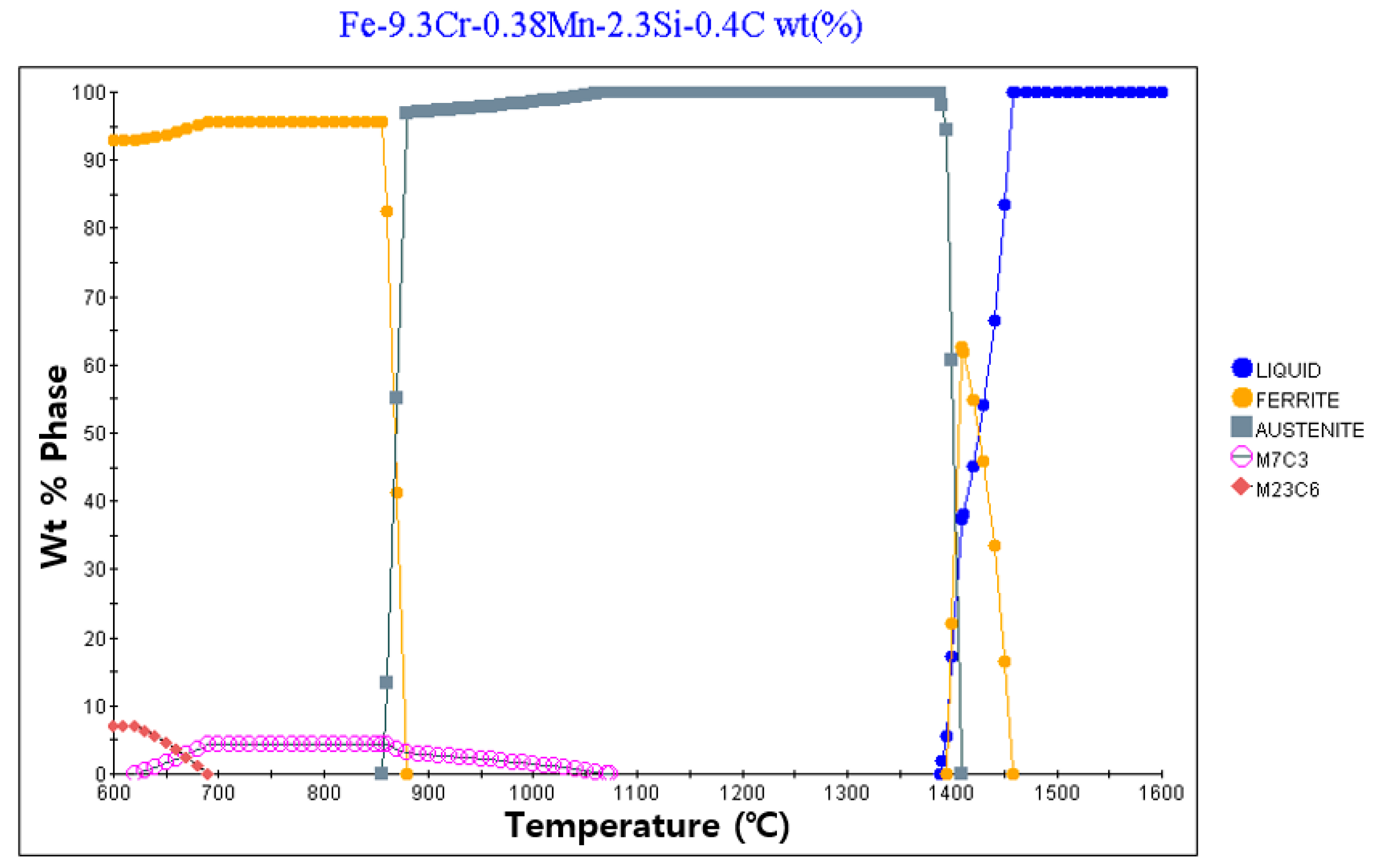
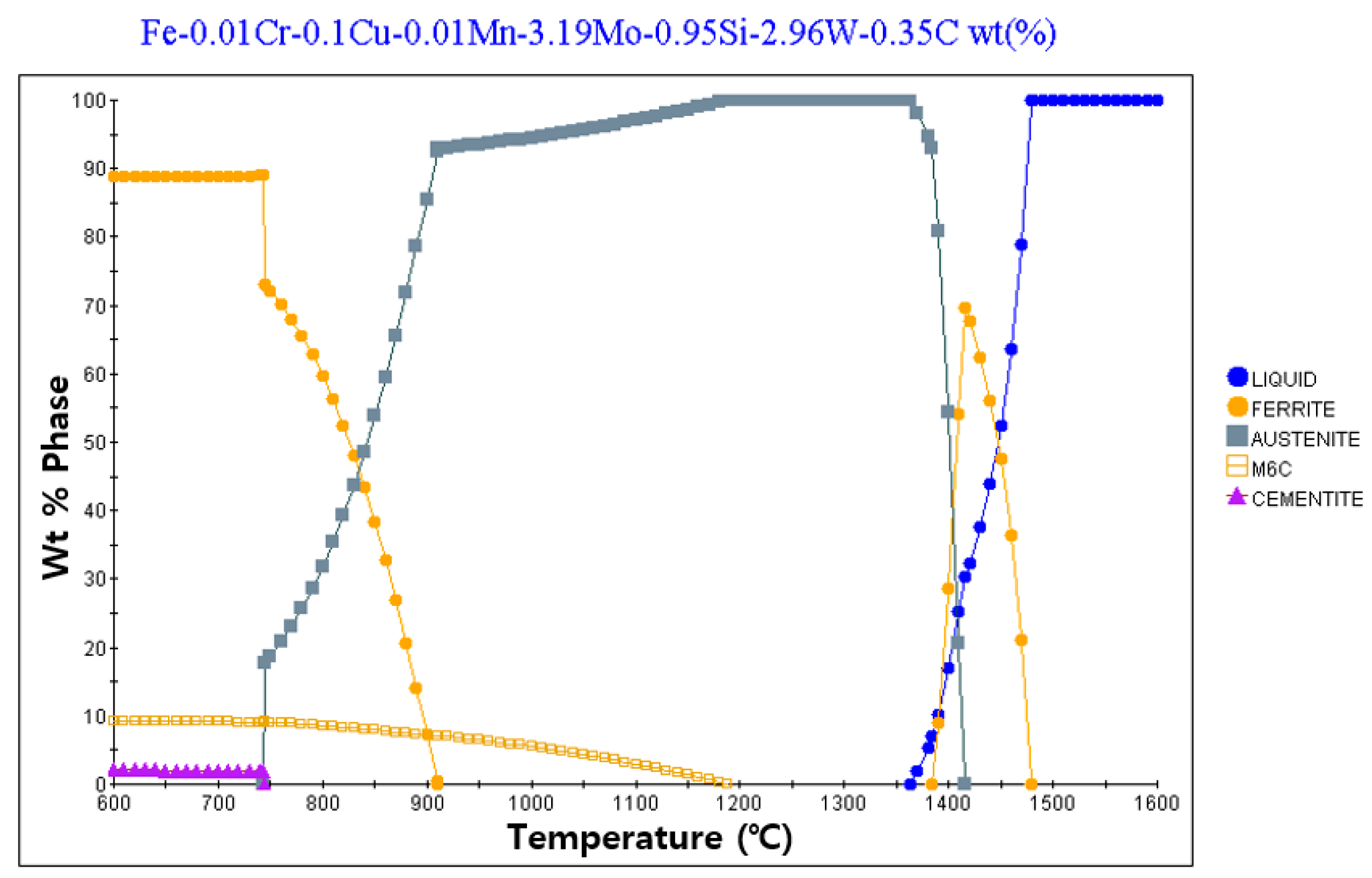
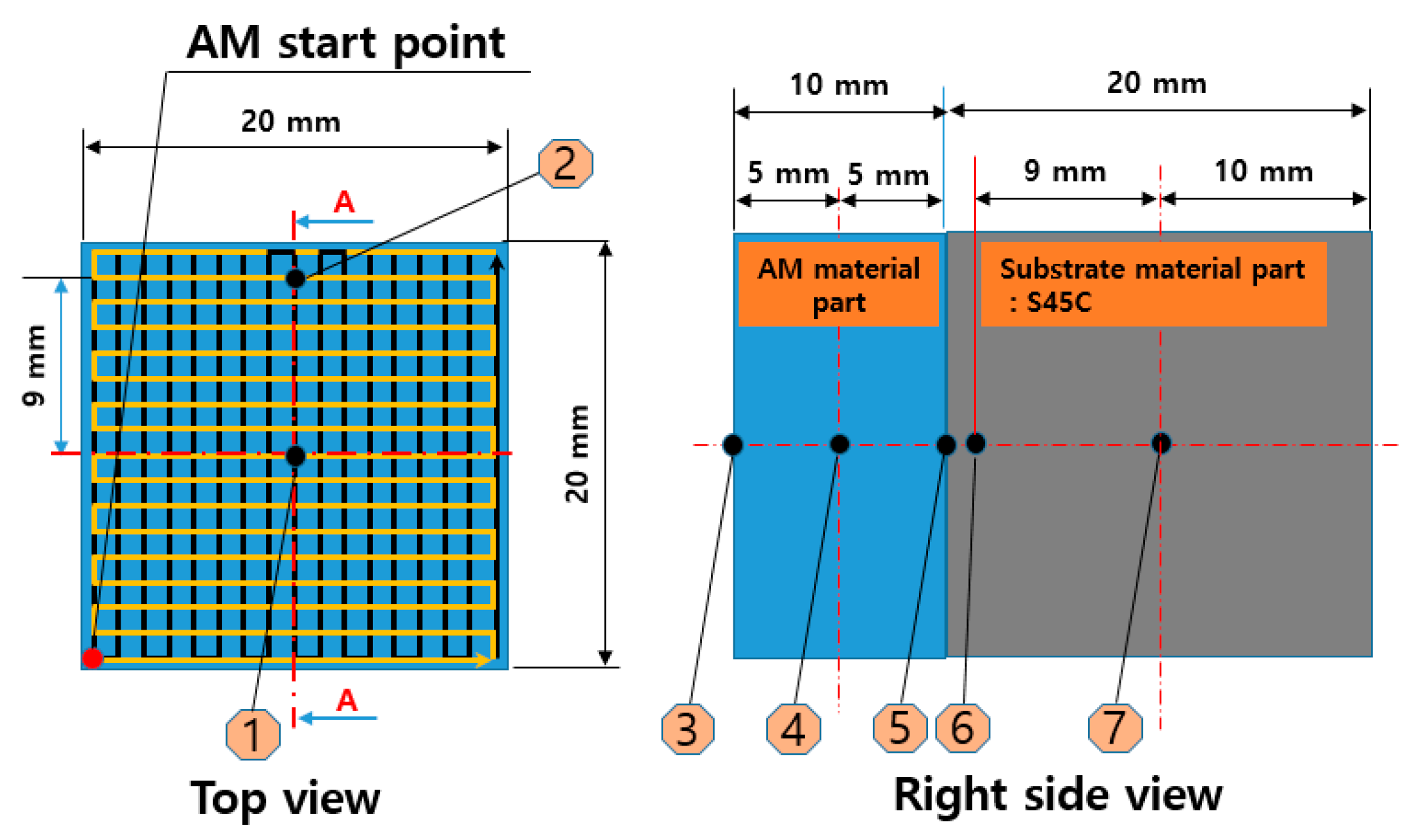


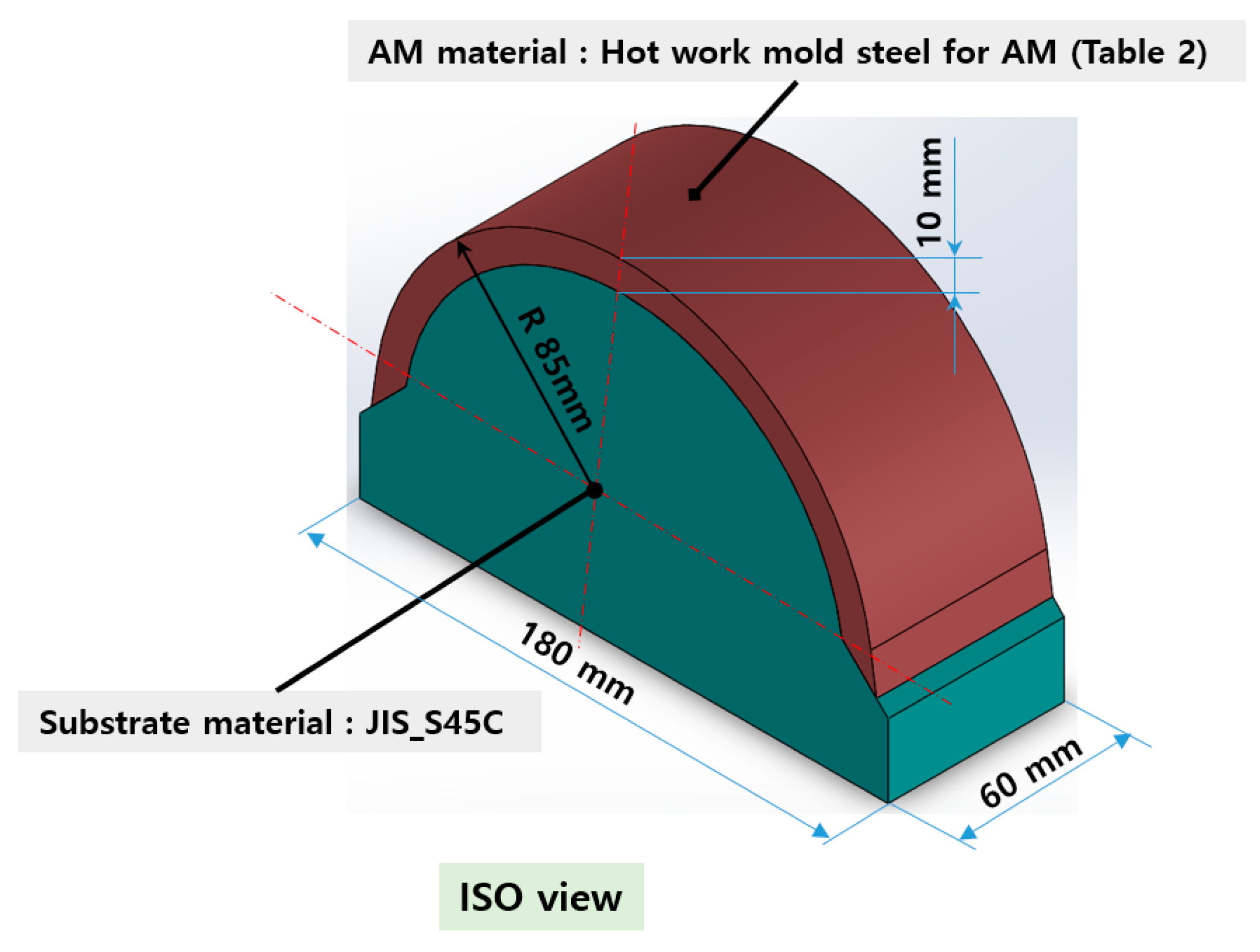

| Soft-Tooling Equipment | Hard-Tooling Equipment | |
|---|---|---|
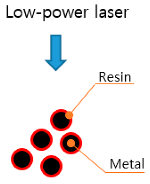 |  | 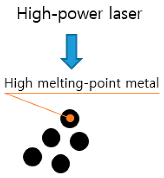 |
|
|
|
| Material Classification | C | Cr | Mn | Si | Ni | Cu | P | S | Mo | W | V | Fe |
|---|---|---|---|---|---|---|---|---|---|---|---|---|
| Substrate material | 0.42 | 0.20 | 0.70 | 0.25 | 0.20 | 0.30 | 0.03 | 0.03 | - | - | - | Balance |
| Cold work mold steel for AM | 0.40 | 9.30 | 0.38 | 2.30 | - | - | - | - | - | - | - | Balance |
| Hot work mold steel for AM | 0.35 | 0.01 | 0.01 | 0.95 | - | 0.10 | - | - | 3.19 | 2.96 | 0.03 | Balance |
| Parameter | Value |
|---|---|
| X-ray generator power (W) | 30 KV.6.7 mA = 200 |
| Radiation Cr K α (nm) | λ = 0.22911 |
| 2θ (°) | 156.40 |
| Miller indices (hkl) | [211] |
| Collimator size (mm) | φ 3 |
| Detector pixel size | 512 |
| Arc radius (mm) | 50 |
| Exp. Time (s) | 20 |
| Tilts | 5/5 |
| Ψ angles (°) | −40/40 |
| Ψ oscillation (°) | 5 |
| Young’s modulus (MPa) | 211,000 |
| Poisson ratio | 0.3 |
| Calculation cross correlation | Linear background |
| Measurement method | Modified X |
| Analysis method [23] | Sin2psi method |
| Maximum measurement error value (MPa) | ±26.7 |
| Parameter | Value |
|---|---|
| Supplied powder (g/min) | 5.5 |
| Supplied powder gas (l/min) | 2.5 |
| Supplied shield gas (l/min) | 7.0 |
| Laser power (W) | 250–600 |
| Deposition speed (m/min) | 0.85 |
| Deposition height per layer (mm) | 0.25 |
| Deposition width pitch per layer (mm) | 0.5 |
| Laser beam diameter (mm) | 0.8 |
| Laser wavelength (nm) | 1060 |
| Parameter | Value |
|---|---|
| Supplied powder (g/min) | 6.5 |
| Supplied powder gas (l/min) | 2.0 |
| Supplied shield gas (l/min) | 7.0 |
| Laser power (W) | 300–450 |
| Deposition speed (m/min) | 0.85 |
| Deposition height per layer (mm) | 0.25 |
| Deposition width pitch per layer (mm) | 0.5 |
| Laser beam diameter (mm) | 0.8 |
| Laser wavelength (nm) | 1060 |
| Set Temperature (°C) | Holding Time After Reaching the Set Temperature (min) |
|---|---|
| 0–100 | 30 |
| 100–150 | 30 |
| 150–200 | 30 |
| 200–250 | 30 |
| Material Type | Measuring Temperature (°C) | Hardness (HRC) | Conductivity (W/mk) | Diffusivity (mm2/s) | Cp (J/g/K) | Density (g/cm3) |
|---|---|---|---|---|---|---|
| Cold work mold steel | 25 | 58–60 | 14.340 | 4.162 | 0.459 | 7.512 |
| Hot work mold steel | 50–52 | 21.107 | 6.378 | 0.419 | 7.898 |
| Measurement Location | Residual Stress Generation Amount According to Laser Power Change (MPa) | |||
|---|---|---|---|---|
| Variable Laser Power 250–600 W | Fixed Laser Power 350 W | Fixed Laser Power 450 W | Fixed Laser Power 550 W | |
| 1 | 262 | 268 | 265 | 285 |
| 2 | 232 | 240 | 271 | 263 |
| 3 | 171 | 238 | 175 | 200 |
| 4 | 305 * | 483 * | 329 * | 301 * |
| 5 | −243 | 34 | −228 | −99 |
| 6 | −212 | −147 | −130 | −176 |
| 7 | −61 | 102 | −121 | −41 |
| Measurement Position | Residual Stress Generation Amount According to Base Material-Heating Temperature Change (MPa) | ||
|---|---|---|---|
| 25 °C | 150 °C | 250 °C | |
| 1 | −140 | −80 | 83 |
| 2 | −153 | −103 | 128 |
| 3 | 278 | 179 | 132 |
| 4 | 495 | 480 * | 317 * |
| 5 | 747 * | 378 | 78 |
| 6 | 506 | 279 | −42 |
| 7 | −63 | 52 | −35 |
| Whole Trial Product | Area “A” Enlarged View | Area “B” Enlarged View | Area “C” Enlarged View |
|---|---|---|---|
 |  |  |  |
| Whole Trial Product | Area “A” Enlarged View | Area “B” Enlarged View | Area “C” Enlarged View |
|---|---|---|---|
 |  |  |  |
| First Trial Product Cleaning | Penetrant Application | Second Trial Product Cleaning | Crack Inspection |
|---|---|---|---|
 | 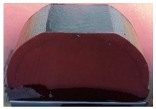 |  | 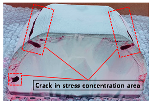 |
| First Trial Product Cleaning | Penetrant Application | Second Trial Product Cleaning | Crack Inspection |
|---|---|---|---|
 |  |  |  |
Publisher’s Note: MDPI stays neutral with regard to jurisdictional claims in published maps and institutional affiliations. |
© 2020 by the authors. Licensee MDPI, Basel, Switzerland. This article is an open access article distributed under the terms and conditions of the Creative Commons Attribution (CC BY) license (http://creativecommons.org/licenses/by/4.0/).
Share and Cite
Hong, M.-P.; Kim, Y.-S. Residual Stress Reduction Technology in Heterogeneous Metal Additive Manufacturing. Materials 2020, 13, 5516. https://doi.org/10.3390/ma13235516
Hong M-P, Kim Y-S. Residual Stress Reduction Technology in Heterogeneous Metal Additive Manufacturing. Materials. 2020; 13(23):5516. https://doi.org/10.3390/ma13235516
Chicago/Turabian StyleHong, Myoung-Pyo, and Young-Suk Kim. 2020. "Residual Stress Reduction Technology in Heterogeneous Metal Additive Manufacturing" Materials 13, no. 23: 5516. https://doi.org/10.3390/ma13235516
APA StyleHong, M.-P., & Kim, Y.-S. (2020). Residual Stress Reduction Technology in Heterogeneous Metal Additive Manufacturing. Materials, 13(23), 5516. https://doi.org/10.3390/ma13235516




